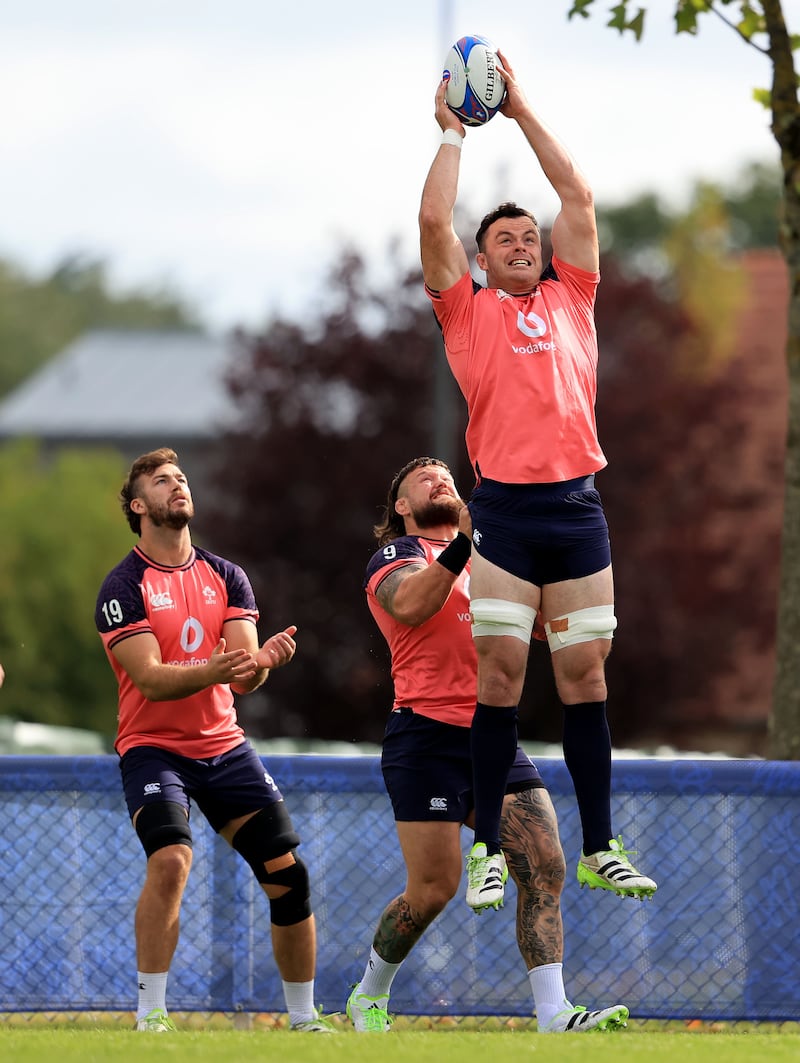In this era of professionalism, of globalisation, of cross-fertilisation in players and coaches and ideas, the boundaries between Irish and South African rugby have never seemed more blurred. Witness the complete role reversal of the Springboks having two current Munster players in their ranks, never mind three coaches who formerly worked with the province.
Yet for all the heightened familiarity at club level since the introduction of the South African Super Rugby quartet to the URC, the countries have only met once at Test level in the last six years, when Ireland prevailed 19-16 in an absorbing contest in Dublin last November.
But aside from the relative novelty value, a Test against the Springboks retains a unique challenge.
“Physicality is the word which springs to mind,” says Caelan Doris before going so far as to admit: “I remember being shocked at just the sheer size of them, playing them in November. They do a 6-2 or even 7-1 sometimes off the bench and have massive reinforcements as well but it’s definitely not the only string to their bow. They’ve got a lot of pace in their backs and their forwards are capable of keeping the ball alive and offloading.
READ MORE
“Obviously the physicality is tied into their set-piece, they’ve got a great maul, great lineout options, a very strong lineout and scrum as well.
“So, getting those areas right is going to be big, our collisions, something we’ve spoken about over the last few weeks, which we haven’t been very happy with going back to the preseason games.
“Even over the last couple of weeks they’ve improved a little bit but it’s going to be a step up this week for sure. Things like two-man tackles, getting our tackle height right, our tackle entry, all those areas are going to be pretty big this weekend.”
As we have seen from their URC sides, South African rugby is replete with game breakers, all the more so with Manie Libbok at outhalf ahead of Handre Pollard, for the time being anyway, as well as the emergence of Kurt-Lee Arendse and the re-emergence of Cheslin Kolbe.
“They have definitely evolved quite a bit,” said Doris in reference to the November meeting. “They were missing a few players back then as well, but that game against the All Blacks three weeks ago or so, some of their attack was very impressive.

“They still have the physical edge, which is in their DNA really, going years back, but they have definitely added layers on top of it.
In addition to their threats out wide, Doris noted the ability of Pieter-Steph du Toit and RG Snyman “to keep the ball alive and offload after having won dominant collisions. Going hard at the breakdown is something we have seen from them over the last while as well. We reckon they will try to disrupt there quite a bit.”
Yet after the flawed Allister Coetzee era – witness Ireland’s 38-3 win in 2017 – the Boks have in many ways reverted to type, under the Rassie Erasmus/Jacques Nienaber ticket. So it is that in the absence of Lukhanyo Am, they opted for the superior defence of the in-form Jesse Kriel alongside Damian de Allende in the suffocating 18-3 win over Scotland, with Canan Moodie not even making the 23 despite his brilliance in the rout of the All Blacks at Twickenham in their final warm-up game.
[ Felix Jones, the Dubliner trying to plot victory for South Africa over IrelandOpens in new window ]
The foundations remain not just their physicality, but their aggression and intimidation. Power plays that beat opponents into submission. They thrive on it, so it is that they’ve gone with a 7-1 split for this game.
“Yes, it is not just their size, it is the way they play. They are very direct off 9. They will sometimes have two or three players latched on to a carrier and try to drive them over the gainline. It is the way they maul. The way they aggressively go after the ruck. It is partly their size and their actual physicality but then partly the mindset and the way they play that comes with that.”
Doris himself has had a relatively low-key World Cup by his exceptional standards, making just two carries against Romania.,But in addition to his maul try against Tonga, there were seven carries, with three defenders beaten and a clean break and try assist. Another Irish try emanated from one of his trademark charges off what he calls “the third set-piece”, ie returning goal line restarts.
So how does a side, which is usually physically smaller, impose themselves on the Boks? Exuding calmness in his easy-going way, Doris said: “We have good ball-playing forwards. We have multiple threats in that we have good carriers but we also have people who are capable of tipping the ball on, giving passes, giving wider passes, so it is not just tuck and carry. There is footwork, passes and the carry threat. Hopefully defences find that a little bit intimidating.”
Normally one of Ireland’s 80-minute men – having started and finished nine of his previous dozen starts before the World Cup - Doris has been withdrawn before the hour in both of Ireland’s matches at the tournament so far. It’s doubtful he will be on Saturday, which adds to the strong suspicion that he is primed for a big game.
Ireland will need one, from him and everyone else.


















